#anemone americana
Explore tagged Tumblr posts
Photo

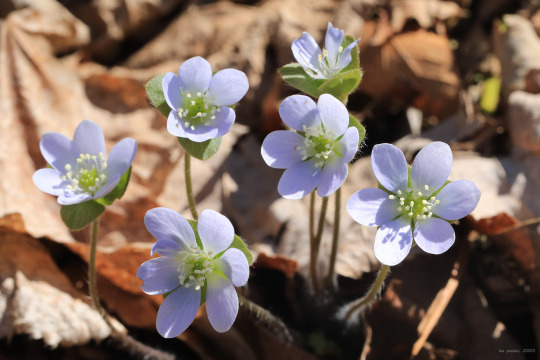

Round-lobed hepatica (Hepatica Anemone americana), one of the earliest-blooming and most beautiful of Central Appalachia’s spring wildflowers, blooms so quickly in late March to early April the flowers are gone before most people notice them. But the plant’s leathery, thrice-lobed leaves persist throughout the year, even through winter. The leaves reminded early mountain folk of the human liver- thus its other common name, liverleaf. Another species - sharp-lobed hepatica (Hepatica Anemone acutiloba) - also occurs locally. You can search from the main blog page for prior posts of both species.
#appalachia#vandalia#west virginia#early april#spring#wildflowers#coopers rock state forest#anemone americana#round-lobed hepatica#blunt-lobed hepatica
237 notes
·
View notes
Text
I fear Haku has taken back the position Rui stole from him. Flower symbolism go boom. (I fell in love again.) Flower and a bit of design study! :D [I think the Haku stans should come together and make a zine about him haha,, unless]

Witty Priest: Lotus: Pure heart, Rest, Sacred, Eloquence, Serenity, and Love that leaves. The three Koi in his card represent the stages of life, from birth to death.

Unworldly Respite: Juniper berries: Protection, Trust, Salvation. White Chrysanthemum: Truth, Adoration, Sincere heart. OR White Gerbera: Unsullied heart. Red anemone: I love you. White Camellia: Perfect beauty, Impeccable charm, and Supreme loveliness.

Ordinary Happiness:
Amana Edulis - "luck will come to you." or Anemone americana - "expectation and joy."
Heliopsis Helianthoides - Longing, adoration, seduction.
Blue Roses: Symbolise the impossible.
White Roses: sincere respect, innocence. Usually, white and blue roses are given as a gift. The blue roses in there would represent blessings while the white ones represent love.
White baby's breath: dreaminess
Veronica: Honor, fidelity, bright home Periwinkle: Happy memories.
Pink rose: warm heart, having love, pledge of love, happiness, gratitude, elegance, and prettiness. Pink rose petals: "Have love," "My heart you only know." FYI for this part: There's no actual Japanese meaning I could find for the petals, but because it's a part of the pink roses, let's be delulu and take it as such.
Additionally, on Haku's vest, there are: Vines with flowers: Beauty and growth intertwined. Vines with leaves: Renewal and continuous personal development. Also, "Good marriage" if the vine ends up being the Chinese Creeper.
[He uses a few Chinese symbols in his design, so if I got the knots wrong, I'd appreciate if you could correct me!!!]
@ghoulspaw @kusanagihaku I think you guys will like this hehe, (ALSO SORRY FOR THE TAG DUHSJBS)
#studying genshin lore payed off for this very moment#+ taking that one flower language my crush was taking also payed off hehe#tokyo debunker#istha rambles#haku kusanagi#istha thoughts#Now to look for other characters who have flowers in their cards so I can make a post for them#tdb
81 notes
·
View notes
Text

Took a walk at a different local park this morning. Didn’t see much to take pictures of but got to see some beautiful pileated woodpeckers close to the ground and not far away. They’re beautiful when their wings are spread. I saw a few rue anemones starting to bloom and the leaves of a couple species of pyrolas, including the lovely leaves of this Pyrola americana.
108 notes
·
View notes
Text
Happy 2025!
I love lists. Here’s the list of seeds I’m starting and plants I’m adding to the landscape this coming spring. My goal this year is to establish the perennial bones of the garden in the sun and partial sun areas of the property. 2026 will be dedicated to the shade and partial shade side.
Native Seeds
New England Aster- Symphyotrichum novae-angliae
Showy Goldenrod- Solidago speciosa
Sweet Goldenrod- Solidago odora
Spotted Bee Balm- Monarda punctata
Wild Bergamot- Monarda fistulosa
Black-eyed Susan- Rudbeckia hirta
Sweet Black-eyed Susan- Rudbeckia subtomentosa
Sundial Lupine- Lupinus perennis subsp. perennis
Prairie Lily- Lilium philadelphicum
Northern Blazing Star- Liatris scariosa var. nieuwlandii
Downy Wood Mint- Blephilia ciliata
Butterfly Weed- Asclepias tuberosa
Common Milkweed- Asclepias syriaca
Tall Thimbleweed- Anemone virginiana
Anise Hyssop- Agastache foeniculum
Pale Purple Coneflower- Echinacea pallida
Purple Coneflower- Echinacea purpurea
Wild Mint- Mentha arvensis
Sweet Joe Pye Weed- Eutrochium purpureum
Hoary Mountain Mint- Pycnanthemum incanum
Canada Wild Rye- Elymus canadensis
Prairie Brome- Bromus kalmii
Prairie Dropseed- Sporobolus heterolepis
Purple Love Grass- Eragrostis spectabilis
Little Bluestem- Schizachyrium scoparium
Native Perennial Bareroots
Wild Strawberry- Fragaria virginiana
Elderberry- Sambucus canadensis
American Hazelnut- Corylus americana
Beach Plum- Prunus maritima
American Plum- Prunus americana
Native-ish Perennial Plants
High bush Blueberry - Vaccinium corymbosum var. “Patriot” “Blueray” and “Northblue”
King of the North Grape- Vitis spp. (V. riparia × Concord-type)
Plants & Seeds still to buy
Rosa setigera and Sunflowers
#new year#spring 2025#native plants#land stewardship#seed starting#pollinators#my garden#food forest
0 notes
Photo

Inktober Day 9 - Round-lobed Hepatica (Anemone americana)
Due to the variety of altitudes we visited, I got to see this one in a few different stages of its life style, which was neat. It had really recognizable leaves too, so every time I saw it, I’d point it out excitedly.
0 notes
Photo



I found some with the leaves - it’s round-lobed hepatica! I’d never seen this blooming before, but the leaves are distinct and persist through the winter, so I’ve gotten to know them. These older leaves will be senescing soon, and new ones will grow after the flowers, so you do find the blooms alone sometimes. They start to bloom facing down, as in the third picture, then turn their faces upwards. They can be purple, white, or pinkish.
Now, although I know exactly what this is, there is an ongoing disagreement about where it should be classified, and thus its Latin name. Is Hepatica its own genus, or are the hepaticas a kind of anemone? Are sharp- and round-lobed hepatica different species, or just varieties of one? I don’t know; I’ll tag this with all of them.
#wildflowers#plant id#hepatica#round lobed hepatica#hepatica americana#hepatica nobilis#hepatica nobilis var. obtusa#anemone americana#anemone
22 notes
·
View notes
Text
𝐓𝐡𝐞 𝐆𝐫𝐞𝐞𝐧𝐡𝐨𝐮𝐬𝐞.
𝘱𝘳𝘰𝘮𝘱𝘵 𝘭𝘪𝘴𝘵!
i have not included all of the flowers or plants here. i went through several dictionaries, and picked those plants that i wanted in the prompt list.

𝐀
Acacia (Acacia). Friendship.
Acacia, rose or white (Acacia). Elegance.
Acacia, yellow (Acacia). Secret love.
Achilliea Millefollia (Asteraceae.) War.
Aconite Wolfsbane (Aconitum). Misanthropy.
Aconite, Crowfoot (Aconitum). Lustre.
Adonis, flos (Adonis). Painful recollections.
African Marigold (Tagetes erecta). Vulgar minds.
Agnus Castus (Vitex agnus-castus). Coldness; indifference.
Agrimony (Agrimonia). Thankfulness; gratitude.
Agapanthus (Agapanthus). Love letter.
Almond (common). Stupidity, indiscretion.
Almond (Amygdalus communis) (flowering). Hope.
Almond, Laurel (Prunus laorocerasus). Perfidy.
Allspice (Myertaceae). Compassion.
Aloe (Aloe vera ). Grief; religious superstition.
Althaea Frutex (Syrian Mallow) (Common Hibiscus). Persuasion.
Alyssum (Lobularia maritima) (Sweet). Worth beyond beauty.
Amaranth (Amaranthus) (Globe). Immortality; unfading love.
Amaryllis (Amaryllis). Pride; timidity; splendid beauty.
Ambrosia (couldn't find the scientific name but the subfamily is Asteraceae). Love returned.
American Cowslip (Primula Meadia). Divine beauty.
American Starwort (Sabulina fontinalis). Welcome to a stranger; cheerfulness in old age.
Amethyst (Browallia Americana). Admiration.
Anemone (Ranunculaceae) (Zephyr Flower). Sickness; expectation.
Anemone (Ranunculaceae) (Garden). Forsaken.
Angelica (Angelica). Inspiration.
Angrec (Angraecum). Royalty.
Apple. Temptation.
Apple (Blossom). Preference ; fame speaks him great and good.
Apple thorn. Deceitful charms.
Ash-leaved Trumpet Flower (Campsis radicans). Separation.
Ash Tree (Fraxinus). Grandeur.
Aspen Tree (some, but not all, are classified in the genus Populus). Lamentation.
Aster (China) (Callistephus chinensis). Variety; afterthought.
Asphodel (Asphodelus). My regrets follow you to the grave.
Auricula (Primula auricula). Painting.
Azalea (Rhododendron). Temperance; fragile and ephemeral passion.
𝐁
Bachelor's Buttons (Centaurea cyanus). Celibacy; single blessedness.
Beebalmn (Monarda). Sympathy.
Balm, gentle (Melissa officinalis). Pleasantry.
Balm of Gilead (Cedronella canariensis). Cure; relief.
Balsam, yellow (Impatiens noli-tangere). Impatience.
Basil (Ocimum basilicum). Hatred.
Bay Leaf (Laurus nobilis). I change but in death.
Bay (Rose) Rhododendron (Rhododendron--that's just the higher classification). Danger; beware.
Bay Tree (Laurus nobilis). Glory.
Baby's breath (Gypsophila paniculata). Everlasting love.
Bearded Crepis (Crepis). Protection.
Belladonna (Atropa belladonna). Silence.
Begonia (Begonia). Caution.
Bellflower (Campanula). Gratitude.
Bells of Ireland (Moluccella laevis). Good luck.
Bird of Paradise (Strelizia reginae). Magnificence.
Blackberry (Rubus). Envy.
Black-eyed Susan (Rudbeckia). Justice.
Bluebell (Hyacinthoides nonscripta). Constancy.
Bougainvillea (Bougainvillea spectabilis). Passion.
Bouvardia (Bouvardia). Enthusiasm.
Broom (Cytisus). Humility.
Buttercup (Ranunculus acris). Ingratitude.
𝐂
Cactus (Opuntia). Ardent love.
Calla lily (Zantedeschia aethiopica). Modesty.
Camellia (Camellia). My destiny is in your hands.
Candytuft (Iberis). Indifference.
Canterbury bells (Campanula medium). Constancy.
Carnation, pink (Dianthus caryophyllus). I will never forget you.
Carnation, red (Dianthus caryophyllus). My heart breaks.
Carnation, striped (Dianthus caryophyllus). I cannot be with you.
Carnation, white (Dianthus caryophyllus). Sweet and lovely.
Carnation, yellow (Dianthus caryophyllus). Disdain.
Chamomile (Matricaria recutita). Energy in adversity.
Cherry blossoms (Prunus cerasus). Impermanence.
Chervil (Anthriscus). Sincerity.
Chestnut (Castanea sativa). Do me justice.
Chrysanthemum (Chrysanthemum). Truth.
Cinquefoil (Potentilla). Beloved daughter.
Clematis (Clematis). Poverty.
Clove (Syzgium aromaticum). I have loved you and you have not known it.
Clover, white (Trifolium). Think of me.
Cockscomb (Celonia). Affectation.
Columbine (Aquilegia). Desertion.
Coreopsis (Coreopsis). Always cheerful.
Coriander (Coriandrum sativum). Hidden worth.
Corn (Zea mays). Riches.
Cosmos (Cosmos bipinnatus). Joy in love and life.
Cranberry (Vaccinum). Cure for heartache.
Crocus (Crocus). Youthful gladness.
Cypress (Cupressus). Mourning.
𝐃
Daffodil (Narcissus). New beginnings.
Dahlia (Dahlia). Dignity.
Daisy (Bellis). Innocence.
Daisy, gerber (Gerbera). Cheerful.
Daphne (Daphne). I would not have you otherwise.
Daylily (Hemerocallis). Coquetry.
Delphinium (Delphinium). Levity.
Dittany (Dictamnus albus). Childbirth.
Dogwood (Cornus). Love undiminished by adversity.
Dragon plant (Draceana). You are near a snare.
𝐄
Edelweiss (Leontopodium alpinum). Noble courage.
Elder (Sambucus). Compassion.
Eucalyptus (Eucalyptus). Protection.
Evening Primrose (Oenothera biennis). Inconstancy.
Everlasting Pea (Lathyrus latifolius). Lasting pleasure.
𝐅
Fennel (Foeniculum vulgare). Strength.
Fern, maidenhair (Adiantum capillus-veneris). Secrecy.
Feverfew (Tanacetum parthenium). Warmth.
Fig (Fiscus carica). Argument.
Flax (Linum usitatissimum). Argument.
Forget-me-not (Myosostis). Forget me not.
Forsythia (Forysthia). Anticipation.
Foxglove (Digitalis purpurea). Insincerity.
Freesia (Freesia). Lasting friendship.
Fuchsia (Fuchsia). Humble love.
𝐆
Gardenia (Gardenia). Refinement.
Geranium, oak-leaf (Pelargonium). True friendship.
Geranium, scarlet (Pelargonium). Stupidity.
Gladiolus (Gladiolus). You pierce my heart.
𝐇
Hawthorn (Crataegus monogyna). Hope.
Hazel (Corylus). Reconciliation.
Heather (Calluna vulgaris). Protection.
Heliotrope (Heliotropium). Devoted affection.
Hibiscus (Hibiscus). Delicate beauty.
Holly (Ilex). Foresight.
Hollyhock (Alcea). Ambition.
Honesty (Lunaria annua). Honesty.
Honeysuckle (Lonicera). Devotion.
Hyacinth, purple (Hyacinthus orientalis). Please forgive me.
Hyacinth, white (Hyacinthus orientalis). Beauty.
Hydrangea (Hydrangea). Dispassion.
𝐈
Ice plant (Carpobrotus chilensis). Your looks freeze me.
Impatiens (Impatiens). Impatience.
Iris (Iris). Message.
Ivy (Hedera helix). Fidelity.
𝐉
Jasmine, Carolina (Gelsemium sempervirens). Separation.
Jasmine, Indian (Jasminum multiflorum). Attachment.
Jonquil (Narcissus jonquilla). Desire.
𝐋
Laurel (Laurus nobilis). Glory and success.
Lavender (Lavandula). Mistrust.
Lettuce (Lactuca sativa). Cold-heartedness.
Liatris (Liatris). I will try again.
Lilac (Syringa). First emotions of love.
Lily (Lilum). Majesty.
Lily of the Valley (Convallaria majalis). Return of happiness.
Lobelia (Lobelia). Malevolence.
Lotus (Nelumbo nucifera). Purity.
Love-lies-bleeding (Amaranthus caudatus). Hopeless but not helpless.
Lungwort (Pulmonaria). You are my life.
Lupine (Lupinus). Imagination.
𝐌
Magnolia (Magnolia). Dignity.
Marigold (Calendula). Grief.
Michaelmas daisy (Aster amellus). Farewell.
Migonette (Reseda odorata). Your qualities surpass your charms.
Moss (Bryopsida). Maternal love.
𝐍
Narcissus (Narcissus). Self love.
𝐎
Olive (Olea europaea). Peace.
Orange (Citrus sinensis). Generosity.
Orange blossoms (Citrus sinensis). Your purity equals your loveliness.
Orchid (Orchidaceae). Refined beauty.
Oregano (Origanum vulgare). Joy.
𝐏
Pansy (Viola). Think of me.
Passion flower (Passiflora). Faith.
Peach (Prunus persica). Your charms are unequaled.
Peach blossom (Prunus persica). I am your captive.
Pear (Pyrus). Affection.
Pear blossom (Pyrus). Comfort.
Peony (Paeonia). Anger.
Peppermint (Mentha). Warmth of feeling.
Periwinkle (Vinca minor). Tender recollections.
Persimmon (Diospyros kaki). Bury me amid nature's beauty.
Petunia (Petunia). Your presence soothes me.
Phlox (Phlox). Our souls are united.
Pineapple (Ananas comosus). You are perfect.
Pink (Dianthus). Pure love.
Plum (Prunus domestica). Keep your promises.
Polyanthus (Primula). Confidence.
Pomegranate (Punica granatum). Foolishness.
Pomegranate blossom (Punica granatum). Mature elegance.
Poppy (Papaver). Fantastic extravagance.
Potato (Solanum tuberosum). Benevolence.
Potato vine (Solanum jasminoides). You are delicious.
Primrose (Primula). Childhood.
Protea (Protea). Courage.
Purple coneflower (Echinacea purpurea). Strength and health.
𝐐
Queen Anne's lace (Ammi majus). Fantasy.
Quince (Cydonia oblonga). Temptation.
𝐑
Ranunculus (Ranunculus asiaticus). You are radiant with charms.
Raspberry (Rubus). Remorse.
Redbud (Cercis). Betrayal.
Rhododendron (Rhododendron). Beware.
Rhubarb (Rheum). Advice.
Rose, burgundy (Rosa). Unconscious beauty.
Rose, moss (Rosa). Confession of love.
Rose, orange (Rosa). Fascination.
Rose, pale peach (Rosa). Modesty.
Rose, pink (Rosa). Grace.
Rose, purple (Rosa). Enchantment.
Rose, red (Rosa). Love.
Rose, white (Rosa). A heart unaquainted with love.
Rose, yellow (Rosa). Infedility.
Rosemary (Rosemarinus officinalis). Remembrance.
𝐒
Sage (Salvia officinalis). Good health and long life.
Scabiosa (Scabiosa). Unfortunate love.
Snowdrop (Galanthus). Consolation and hope.
Spirea (Spiraea). Victory.
Starwort (Stellaria). Welcome.
Stephanotis (Stephanotis floribunda). Happiness in marriage.
Stock (Malcolmia maritima). You will always be beautiful to me.
Stonecrop (Sedum). Tranquility.
Strawberry (Fragaria). Perfection.
Sunflower (Helianthus annus). False riches.
Sweet briar (Rose rubiginosa). Simplicity.
Sweet pea (Lathyrus odoratus). Delicate pleasures.
𝐓
Tansy (Tanacetum). I declare war against you.
Thistle, common (Cirsium). Misanthropy.
Thrift (Armeria). Sympathy.
Trillium (Trillium). Modest beauty.
Trumpet vine (Campsis radicans). Fame.
Tuberose (Polianthus tuberosa). Dangerous pleasures.
Tulip (Tulipa). Declaration of love.
𝐕
Verbena (Verbena). Pray for me.
Violet (Viola). Modest worth.
𝐖
Water lily (Nymphaea). Purity of heart.
𝐘
Yarrow (Achillea millefolium). Cure for a broken heart.
𝐙
Zinnia (Zinnia). I mourn your absence.

14 notes
·
View notes
Photo


First wildflowers of the season! Round lobed hepatica (Anemone americana), Carolina spring beauty (Claytonia caroliniana), and Dutchman’s breeches (Dicentra cucullaria). The trout lilies are looking promising too.
7 notes
·
View notes
Photo


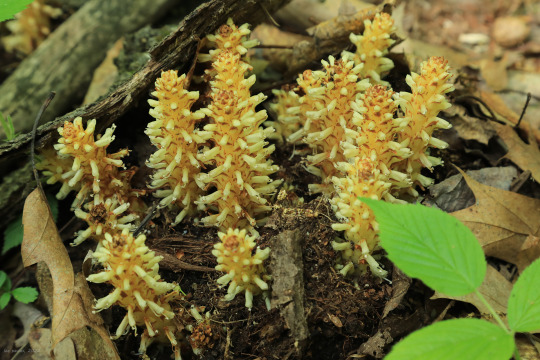



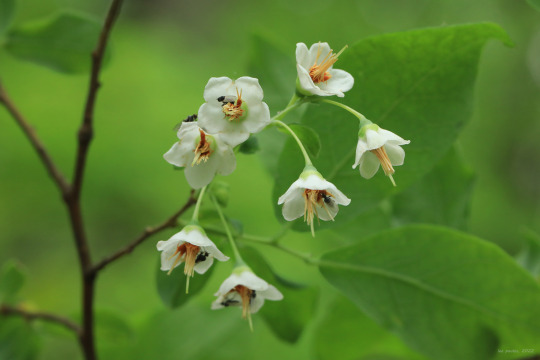
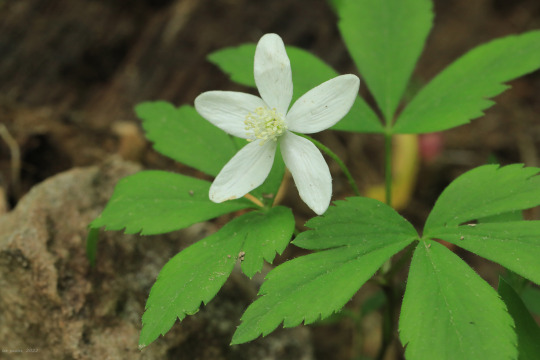


Although the spring ephemerals are all but gone now, I like to believe the end of one good thing is the beginning of another. Mid-May to early August is orchid season in Appalachia, and a number of temperate varieties are as ostentatious and dramatic as their tropical cousins. One of the first orchids out of the gate in this area is pink lady's slipper (Cypripedium acaule), also known as moccasin flower. This showy perennial monocot is currently at peak bloom at Coopers Rock State Forest. The photos above are from a hike on Scott Run Trail this past Sunday.
From top: American cancer-root (Conopholis americana), a fully parasitic plant that attaches to the roots of oak trees; whorled wild yam (Dioscorea quaternata), also known as fourleaf yam, a twining, herbaceous vine with a long history of medicinal use by Native Americans and herbalists; perfoliate bellwort (Uvularia perfoliata); a sylphlike perennial that is for me the loveliest of all the bellworts in our local woods; deerberry (Vaccinium stamineum), whose large fruits are much sought after by local wildlife, including white-tailed deer; one of the last wood anemones (Anemone quinquefolia) still in bloom along the trail; and pink lady’s slipper orchid, whose bulbous pink flower is a highly-evolved bee lure and trap that aids in pollination.
#appalachia#vandalia#west virginia#coopers rock state forest#scott run trail#spring#flora#wildflowers#conopholis americana#american cancer-root#dioscorea quaternata#whorled wild yam#fourleaf yam#uvularia perfoliata#perfoliate bellwort#vaccinium stamineum#deerberry#anemone quinquefolia#wood anemone#nightcaps#cypripedium acaule#pink lady's slipper#orchid
47 notes
·
View notes
Photo

Anemone americana - Round-lobed Hepatica in the Baraboo Hills WI
4 notes
·
View notes
Photo


Two shades of hepatica. There is also a white variation.
#hepatica nobilis#anemone americana#anemone hepatica#hepatica americana#the one with all the Latin names!#round-lobed hepatica
198 notes
·
View notes
Text




Wildflowers on the trails today. Trillium bud and blooms on Anemone americana and Cardamine angustata. I do not know what the last flower is, perhaps @samfordmom2 can identify it. Most of the wildflowers in bloom are drooping and not fully open due to heavy rains and high winds this week.
Personal photos, Wildflower and Old Railroad Bed Trails, Land Trust of North Alabama. 2/21/19
#hiking#wildflowers#wildflower trail#old railroad bed trail#land trust of north alabama#trillium#anemone#toothwort#spring is coming#sweet home alabama
16 notes
·
View notes
Photo


Not as common to see in bloom this time of year, (March and early April), when compared to the similar blue or white blooms of Hepatica acutiloba; It's still a species I would keep a lookout for just for fun.
Round Leaf Hepatica
Anemone americana or Hepatica nobilis var. obtusa (more accepted atm)
Growing in the sand bank along one of the many tributaries feeding the Copperas Creek, RRG, KY.
3 notes
·
View notes
Photo

Round lobed hepatica (Anemone americana), a memeber of the buttercup family. Its leaves are liver colored in winter, which can remind you that it is a liver herb in appalachian medicine. Like other members of the buttercup family, it contains alkaloids that are very bitter and provocative to the liver (and presumably poisonous in large doses). It’s a powerful laxative that causes movement of a lot of green bile. This is seldom what i am going for in my clinical practice, so i don’t use it much at all. But that sort of drastic remedy used to be more in fashion than it is now. The little round leaves around it are partridgeberry (Mitchella repens), which is a gentle tonic for the endocrine system, especially in women. I use it pretty often. It is a woodland perrenial that is not cultivated, so it should only be gathered by people who are familiar with and can carefully monitor the population of the stand it is growing in. . . . . #leaves #plantmedicine #wildmedicine #earthmedicine #naturalremedy #herbalism #appalachia https://www.instagram.com/p/Btg6-y9Bqu8/?utm_source=ig_tumblr_share&igshid=19een3lrlxkvo
5 notes
·
View notes
Photo

Round-Lobed Hepatica (Anemone americana) (5/10/13) Northern Minnesota
0 notes
Text
Last year, I wrote a post on some wasps and bees I’ve found in my garden over the nine years I’d lived here. This is the second installment of the Garden Insects series, on butterflies & moths and their larvae. Future posts will cover flies, dragonflies, ants, beetles, grasshoppers, cicadas, and other bugs — some “true” bugs and some not. Possibly even worms and slugs, though they are not insects, or even in the same phylum as insects. Speaking of phylum …
_________________
SIDEBAR: The taxonomy of the insect world, briefly.
Insects are a CLASS in terms of taxonomy, within the PHYLUM called Arthropoda that’s part of the overarching KINGDOM Animalia, which contains about 2.2 million animal species, So yes, all insects are animals, though people often dispute this in casual conversation and social media.
Depending on how a phylum is determined (including whether only extant (non-extinct) animals are included or not), there are anywhere from 5 to 36 phyla in the animal kingdom; usually lists show 7 or 9 phyla, such as this one from a Yale University course that lists 9 phyla, the first 6 of which contain animals that live only in water or mud: Porifera (Sponges), Cnidaria (Jellyfish, Coral, Sea Anemones), Mollusca (Snails, Slugs, Octopus), Echinodermata (Starfish, Sand Dollar, Sea Cucumber, Sea Urchin), Annelida (Segment Worms, Leeches), Platyhelminthes (Flatworms), Nematoda (Nematodes, Roundworms, Earthworms), Chordata (everything with a backbone, so all Birds, Reptiles, Fishes, Amphibians and Mammals, including humans), and finally, Arthropoda (Insects, Spiders, Scorpions, Millipedes, Crustaceans).
This sortable list on Wikipedia, similar to a BBC Earth list, contains 35 phyla, but often many of these are considered a sub-phylum of a more encompassing phylum. Here’s a site that lists 21 phyla, while the Tree of Life project lists just 6: Porifera and Cnidaria, as above in the list of nine, but then none of the other seven, instead adding to and replacing them with Placozoa (extremely simple animals up to 3mm in size made up of only 4 cell types; only 2 species have ever been described), Ctenophora (comb-jellies), Myxoza (several-celled parasitic microscopic organisms) and the giant group of Bilateria, which includes all the vertebrates plus arthropods, molluscs, worms, and more!
Categorising life is complicated.
And don’t get me started on the top level of life Kingdoms (or Domains or Empires):
“In summary, today there are several competing top classifications of life:
The three-domain system of Carl Woese, with top-level groupings of Archaea, Eubacteria, and Eukaryota domains
The two-empire system, with top-level groupings of Prokaryota (or Monera) and Eukaryota empires
The five-kingdom system with top-level groupings of Monera, Protista, Fungi, Plantae, and Animalia
The six-kingdom system with top-level groupings of Archaebacteria, Monera, Protista, Fungi, Plantae, and Animalia
Overall, the majority of biologists accept the domain system, but a large minority uses the five-kingdom method.” (from New World Encyclopedia: Taxonomy)
So, leaving the weeds to recap for today’s posting on insects, insects comprise one CLASS (called Insecta) of the PHYLUM Arthropoda, which also contains, in other classes (not Insecta) such animals as arachnids (spiders, scorpions, ticks, mites, et al.), crustaceans, millipedes and centipedes, horseshoe crabs, and so on.
Within the CLASS Insecta are about 30 ORDERS, including our focus today, Lepidoptera (butterflies and moths), plus:
Hymenoptera: ants, bees, wasps, sawflies … it’s a big group Hemiptera: all true bugs, within three sub-orders: Heteroptera – bugs; Auchenorrhyncha – cicadas, leafhoppers; and Sternorrhyncha – aphids, scales. True bugs are insects that have two pairs of wings and hypodermic-needle-like mouthparts, and they all undergo incomplete metamorphosis, with their young hatching from eggs to become nymphs, which are miniature versions of the adult bug minus the wings. Diptera: flies — but not all insects with the word “fly” in their names; also mosquitoes Coleoptera: beetles Orthoptera: katydids, grasshoppers, crickets Odonata: dragonflies & damselflies, each in its own sub-order Trichoptera: caddisflies Ephemeroptera “lasting a day”: mayflies Mantodea “like a prophet”: mantises Phasmatodea “like a ghost”: walking sticks
… and a couple dozen more. (Check out Bugguide’s intro or the list here.)
_________________ END OF SIDEBAR
*
Now on to the butterflies and moths, and their larva, i.e., caterpillars. (All photos from my yard this year unless noted otherwise.)
What’s interesting to me is that I commonly see both the larval and adult forms of some butterfly species, such as monarch butterflies and caterpillars (Danaus plexippus), while I typically see only either the larval or the adult form of others, such as black swallowtail butterflies (Papilio polyxenes); I’ve seen a handful of black swallowtail caterpillars in my yard this year and no adults, though I’ve seen a few flying around town. Same thing with yellow swallowtail butterflies, either Eastern tiger, Papilio glaucus or Canadian tiger, Papilio canadensis — I’m never sure which; I see lots of adults and no caterpillars, which are darned cute.
(Male) monarch butterfly, 12 Aug 2019; monarch caterpillar, 25 July 2019:
I like this monarch-in-flight photo that the motion camera caught on 2 Aug. 2019.

I’ve had two chrysalises hatch successful adult monarch butterflies in the garden, and I’ve seen at least three dozen monarch caterpillars on the milkweed plants (Asclepias syriaca and A. incarnata) since mid-July, including one large one today, which is getting to be too late for pupating, hatching, and flying to Mexico.
*
Black swallowtail butterfly, in the garden in Sept. 2015 ; black swallowtail caterpillar, 17 Sept 2019:
I’m still seeing black swallowtail caterpillars on dill in the garden now, too.
*
These are both Eastern yellow tiger swallowtails, both photographed on 25 July 2019; the one on the left is a female (more blue), the one on the right a male. I don’t have any photos of yellow tiger caterpillars, never having noticed one, but here’s one online — cute, right? Kind of like a spicebush caterpillar.
*
Similarly with MOTHS: I’ve seen loads of tussock moth caterpillars this year — it’s been a banner year for them in the northeast — but no adult tussock moths (they are beige and somewhat nondescript):

spotted tussock moth caterpillar (Lophocampa maculata) foreground, and looks like a banded tussock moth caterpillar (Halysidota tessellaris) in the background – 11 Sept 2019
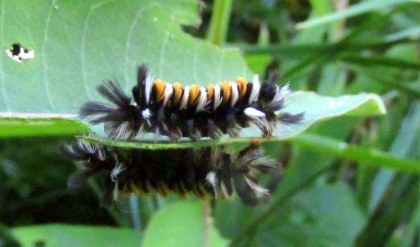
milkweed tussock moth caterpillar (Euchaetes egle), on milkweed – 25 Aug 2019
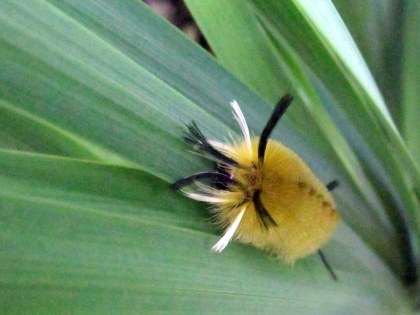
banded tussock moth caterpillar (Halysidota tessellaris) – 13 Aug 2019
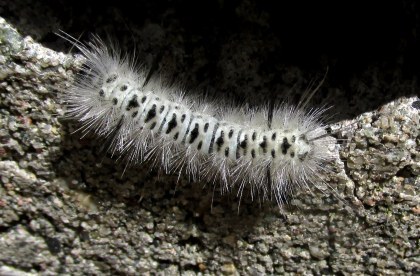
hickory tussock moth caterpillar (Lophocampa caryae) – 11 Aug 2019
*
I’m likewise seeing a fair number of woolybears, those fuzzy caterpillars of the banded woolybear moth aka Isabella tiger moth, Pyrrharctia isabella or of the yellow woolybear moth, aka Virginian tiger moth, Spilosoma virginica, but I’ve not noticed any actual moths of the species:
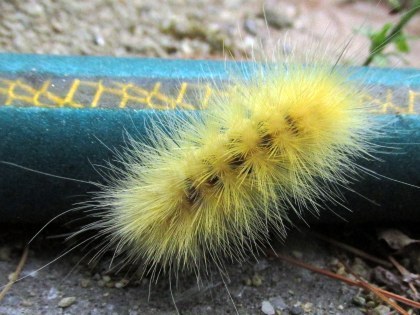
I think this is a Yellow Woolybear Moth caterpillar aka Virginian Tiger Moth (Spilosoma virginica), on the garden hose, 12 Aug 2019

And this is another Virginian Tiger Moth (Spilosoma virginica), seen not in my garden but at Laudholm Farm in Wells, Maine on 9 Sept. Quite different in appearance.
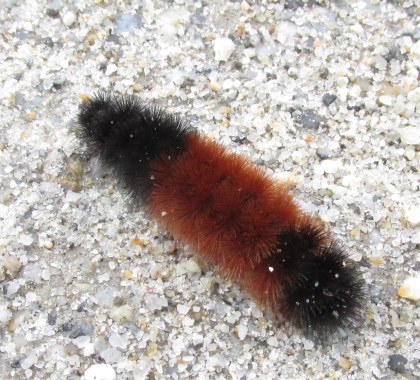
Here’s a banded woolybear moth caterpillar aka Isabella tiger caterpillar (Pyrrharctia isabella), taken nearby my home in New Hampshire last year, Oct. 2018; I’ve seen some this year but haven’t been able to get photos.
Obviously, I’m probably just not noticing or recognising the moths in their adult forms (they tend to blend), and I’m not out at night prowling around or leaving lights on to lure them, but the swallowtail situation is more perplexing to me, as they are fairly striking in both forms.
*
A new one for me this year has been the American dagger moth caterpillar (Acronicta americana). I first saw it coiled in a round disk on the patio (27 July) and wasn’t sure it was even an animal.

But folks on Facebook insect pages assured me it was. I’ve since seen the same species in other spots in the yard. Here’s a bedraggled one on a peach, 3 Sept.:

Here’s another, all curled up in a small Japanese maple (‘Bloodgood’) tree a few days ago.

There’ve been other dagger moth caterpillars around as well, including these larvae of the splendid dagger moth (Acronicta superans), both seen on 19 Aug. 2019 but at least 15 yards from each other, the first on a purple leaf sand cherry (Prunus × cistena) and the second on the shed.

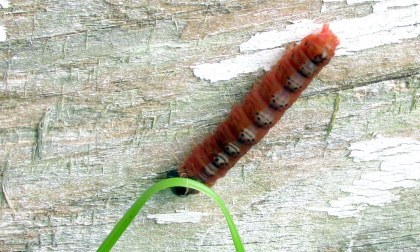
I saw this one on a sidewalk in town on 16 Aug. 2019; it’s a fingered dagger moth caterpillar.

fingered dagger moth (Acronicta dactylina) caterpillar, 16 Aug. 2019
And this one also in town, on 13 Sept. 2019, a yellow-haired dagger moth (Acronicta impleta) caterpillar:
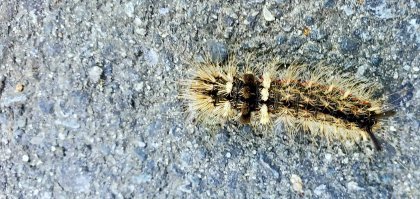
*
A couple more moth larva seen locally this summer:

rosy maple moth (Dryocampa rubicunda) caterpillar, 22 Aug. 2019, on a local trail

a polyphemus moth (Antheraea polyphemus) caterpillar ready to pupate (this is why it’s orange and not green), 26 Aug 2019, on a local sidewalk and heading toward the road (I moved it)
*
The clymene moth (Haploa clymene), a kind of tiger moth, is a very distinguishable species that I seem to see about once a summer on the lawn. This photo was taken on 30 July 2019. I’ve never noticed it in its larval form, which somewhat resembles a webworm.

*
This ipsilon dart moth was a new one for me, and I might not have noticed it on the ground if it hadn’t moved a bit. I posted it two two Facebook insect ID groups and I’m amazed that with the sunlight glaring on this specimen, two people in two separate groups actually recognised it!

Agrotis ipsilon (Ipsilon dart) moth, 8 Sept 2019
*
Another new one for me is this tiny boldly marked Archips moth (Archips dissitana), seen on Clintonia borealis (blue-bead lily) alongside a local trail, 28 July 2019; sorry it’s a bit blurry:
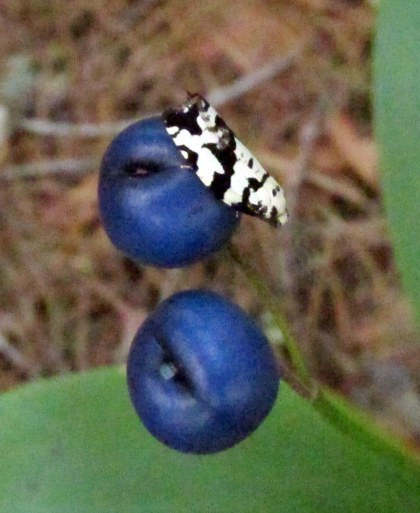
boldy marked Archips moth (Archips dissitana) on Clintonia bead, Sutton, NH, 28 July 2019
*
This giant luna moth (Actias luna) was a new and serendipitous sighting for me as well!

luna moth (Actias luna) on a local bakery storefront, 30 June 2019
*
Two moths that look more like tiny hummingbirds are the clearwing moths: the hummingbird clearwing (Hemaris thysbe) that’s olive and reddish-brown, and the snowberry clearwing (Hemaris diffinis), which is black and yellow. We’ve had many of both here all summer.
This is the hummingbird clearwing (Hemaris thysbe), on bee balm (monarda) and buddleia ‘Ellen’s Blue’:
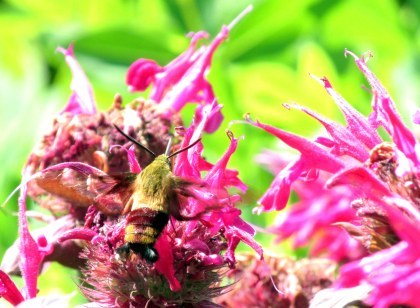
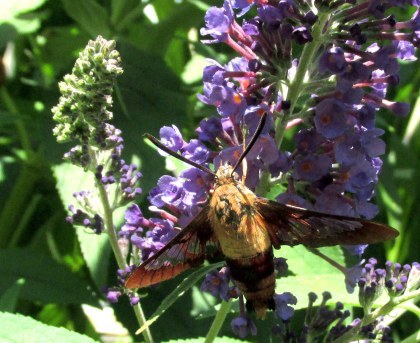
And this is the snowberry clearwing (Hemaris diffinis), on buddleia ‘Ellen’s Blue’:


I love the curled proboscis in the second photo.
*
BACK TO BUTTERFLIES
Besides the monarch and yellow swallowtails, above, another butterfly showing up here in droves this season is the painted lady (Vanessa cardui). I can’t decide if it’s more beautiful from the side or with wings open. (Shown here, on 10&11 Sept.) on buddleia, sedum, and Joe Pye weed.) There are still a lot of them around even now.
I guess I like the side the best!
Oddly, a naturalist writer near Keene, NH, about 50 miles southwest, said last week that he hasn’t seen any painted ladies this summer!
We’ve also had a fair number of American lady butterflies (Vanessa virginiensis) this season. They have only two big circles on the side of the wing, and the markings on their hindwings are quite different, too. (Shown here, from 24 July – 24 Aug,, on clethra ‘Ruby Spice’ and echinacea)
And look, I actually managed to find the larval form of the American lady!

*
I haven’t seen many white admiral butterflies (Limenitis arthemis) in the garden this year, but was able to photograph the tattered varmint on buddleia on one of the few days when I did (11 Sept. 2019). It’s a strange species, having two very different forms that used to (understandably) be considered two separate species; one is a red-spotted purple form, and the other is the “white” version, which is really black, white, blue, and reddish.

Last year I spotted one on a rotting peach (4 Sept 2018).
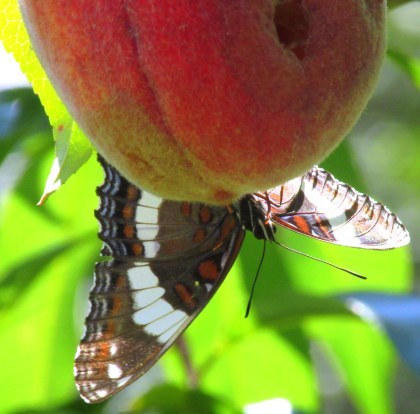
And here’s the red-spotted purple version on buddleia in the garden, seven years ago, on 1 Aug. 2012
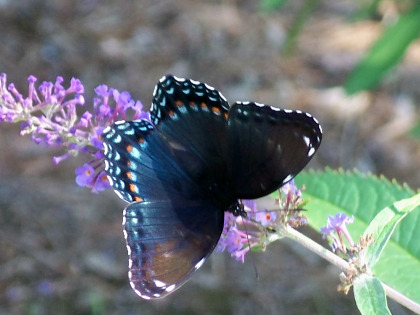
*
Early in the season we had some small fritillaries, which are so common in the south (Jekyll island, GA, for instance – especially gulf fritillaries) but not as much up here. This one was seen on 24 July 2019. I think it’s a great spangled fritillary (Speyeria cybele). We also have an aphrodite fritillary (Speyeria aphrodite) here, somewhat smaller but otherwise I can’t tell them apart.

*
These are all skippers, a small butterfly; I don’t know their species (there are almost 40 species of skippers in New Hampshire). There were a bunch around the yard in July.

27 July 2019

11 Aug. 2019 on echinacea … maybe Peck’s skipper (Polites peckius)
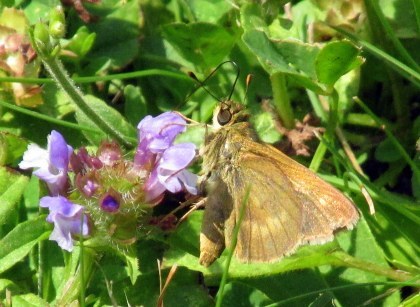
27 July 2019 on self-heal in the lawn
*
I saw a few duskywing butterflies (genus Erynnis, a kind of skipper) in July and August, including this one (I think):

duskywing butterfly (Erynnis spp) on echinacea, 3 Aug. 2019
There are 12 or so species of duskywing, sootywing, and cloudywing butterflies in New Hampshire and they all look kind of alike.
*
Here are a few more butterflies I’ve seen this year in places that aren’t my garden.
This one wasn’t even in New Hampshire, but I rarely see an Eastern comma (Polygona comma) butterfly:

Eastern comma butterfly (Polygonia comma), Laudholm Farms in Wells, Maine, 9 Sept. 2019
A couple of sightings of the common buckeye butterfly (Junonia coenia).
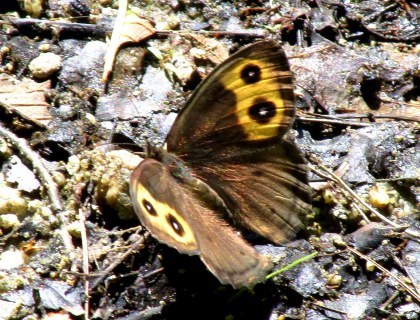
New London, NH, 26 Aug. 2019
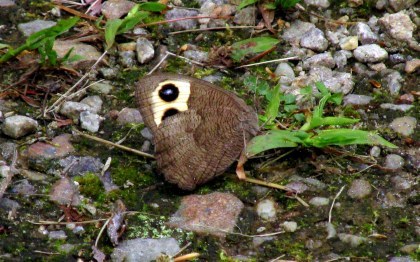
Great Bay NWR, Newington, NH, 23 Aug. 2019
*
A northern spring azure (Celastrina lucia) — I see many azures (both spring and summer species) but they are very small and very fast, hard to capture on film.
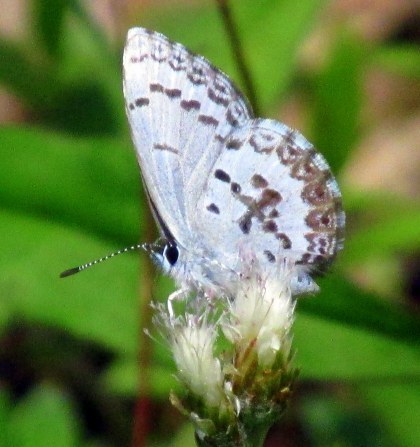
northern spring azure butterfly (Celastrina lucia), 25 May 2019
*
A crescent butterfly, probably a northern crescent (Phyciodes cocyta), but possibly a pearl crescent (Phyciodes tharos).

crescent butterfly, Enfield, NH, 19 June 2019. There are three kinds in NH — tawny, northern, and pearl; I think this is the northern crescent (Phyciodes cocyta).
*
A clouded sulphur (Colias philodice) butterfly, at The Fells Estate in Newbury, NH, 22 Sept. 2019, on pink asters:
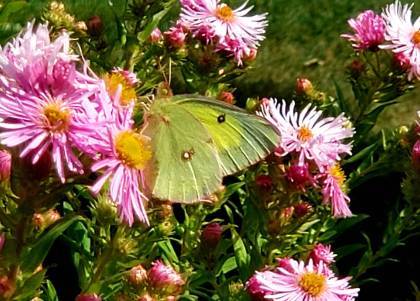
*
This eyed brown (Satyrodes eurydice) butterfly was a new one for me. The common names — eyed brown and marsh eyed brown — just sounds incomplete to me. There’s also a Satyrodes appalachia, Appalachian brown or woods eyed brown, which is very similar (they were previously thought to be the same species), and it’s possible that’s what this is, but people who know more than I do about these things identified it as S. eurydice.
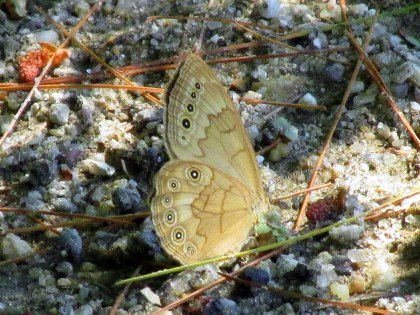
Satyrodes eurydice (Eyed Brown/Marsh Eyed Brown butterfly), Sutton, NH, 5 July 2019
*
Finally, these butterflies are fairly common here but I haven’t taken any photos of them (or even noticed a copper) yet this year, so I’m including garden photos from previous years.

cabbage white (Pieris rapae) butterfly on ‘Bluebird’ Aster laevis, 27 Sept. 2018.
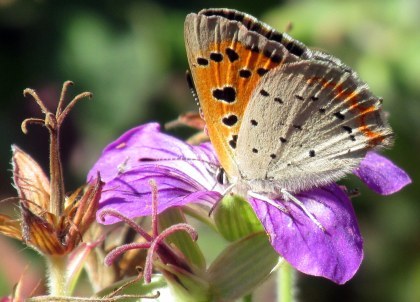
American copper (Lycaena phlaeas) butterfly on geranium, 18 Sept. 2015
I’ve never seen a mourning cloak (Nymphalis antiopa) in my garden but I see them along some trails in early spring; their our earliest butterflies. I actually saw one this spring but couldn’t get a good shot of it, so here’s a mourning cloak along a trail in Concord, NH, 23 April 2016.
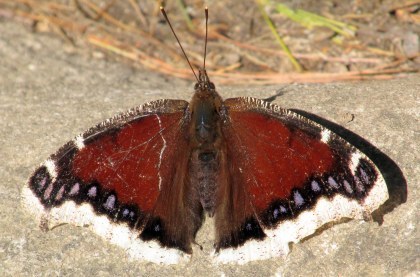
*
Sources:
The Animal Kingdom, by Joe Lewis, Yale-New Haven Teachers Institute Ask a Biologist: True Bugs, by Adam Dolezal and Page Baluch Phylogenic List of Insect Orders Hummingird Moth (Mass Audubon) Side-by-Side American Lady and Painted Lady butterflies (Mass. Butterfly Club) Wildlife Journal Junior – NH PBS – list of insects (mostly butterflies) in NH
Featured image: monarch butterfly drying wings after eclosing, 11 Sept. 2019.
Garden Insects: Butterflies, Moths, and Caterpillars (Lepidoptera) Last year, I wrote a post on some wasps and bees I've found in my garden over the nine years I'd lived here.
#American lady#butterflies#caterpillars#clearwing moths#dagger moth#fritillary#insects#larva#lepidoptera#monarch#moths#painted lady#skipper#swallowtail#taxonomy#tiger moth#tussock moths
0 notes